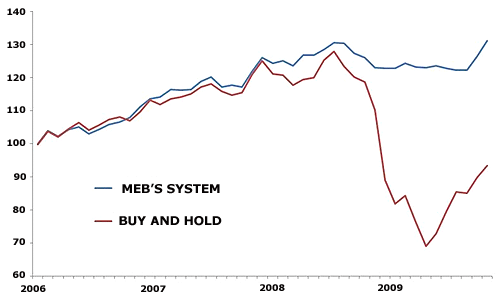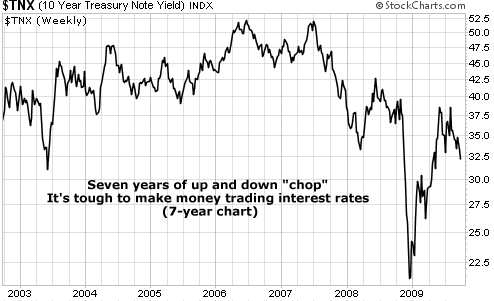| Home | About Us | Resources | Archive | Free Reports | Market Window |
This System Works So Well, I'm Not Sure I Should Tell You About ItBy
Friday, October 2, 2009
If I weren't working on the same research myself, I wouldn't have believed it's possible...
The results of this system are so powerful, I hesitate to share them with a large audience. But I get paid to share the best investment ideas I find. So I feel compelled to tell you about this one... In short, investment analyst Mebane Faber came up with an incredibly "dumb" system that beats the market. It crushes it actually... Meb's system delivers the investment "Holy Grail" – higher returns with lower risk. It's hard to believe, but the system really is incredibly simple. And it's totally legit. While the traditional disclaimer "past performance doesn't equal future performance" applies, the fact is: From 1973 (the start date for his data) through 2007, Meb's simple system never had a losing year. (Think about that!) In 2008, when everyone lost money, Meb's simple system beat everything and was barely down. (I'm not sure what the exact figure was, but I assure you, it was only slightly negative.) I remembered Meb's story when I opened up the most recent issue of Fortune... It turns out, Harvard and Yale's college endowments are down 27% and 25%, respectively, in the 12 months ending June 30. I tell you this because I first learned of Meb's system in a book he wrote, called The Ivy League Portfolio: How to invest like the top endowments and avoid bear markets. The book is interesting... He shows you how Harvard and Yale have beaten typical money managers over the long run, among other investment ideas. It's worth owning just for that section. But what interested me most wasn't Harvard's famous system in the front half... it was Meb's unknown system later in the book. Way in the back, after all the stuff about the endowments, I found Meb's little timing system. He wrote the book before the Great Recession. How has his system performed since? It's hitting new highs:  But that's the way it's always been... I think the worst performing 12-month period (out of all possible intra-year 12-month periods) was a loss of less than 10%. Great stuff. In the simple version of Meb's system, you only look at the markets 12 days of the year. And there are only five funds to own: U.S. stocks, foreign stocks, bonds, commodities, and real estate stocks. In Meb's system, you have 20% of your portfolio in each of these five asset classes... and you are either in or out of each of them every month. So you might be only 40% invested one month, then 80% invested another month, depending on the system. Look, Mebane Faber came up with this system... and he deserves credit for it... So I'm going to ask you to get it from him. Go to www.TheIvyPortfolio.com and get his book. Read his blog. If you want to know the "science" behind it, click on the "Timing Updates" tab and download his academic paper. It's worth learning... It's had only one down year since starting in 1973. And it's delivered the investment "Holy Grail" of higher returns with lower volatility... all in a portfolio of just five things that you only have to look at a dozen times a year. What more could you want? Check it out: www.TheIvyPortfolio.com. Good investing, Steve
Further Reading:
The Government Doesn't Want You to Use This Amazing Strategy Market NotesTHIS TRADE WILL DRIVE YOU CRAZY
Today's chart is a reminder that one of the world's most popular bets is one that will drive you nuts: It's the past seven years in U.S. interest rates.
Folks love to predict interest rates. Real estate agents always predict higher rates and remind you to "lock in a low rate now." Speculators study all kinds of government reports to guess where interest rates are going. And many folks believe Uncle Sam's creditors will demand higher rates in order to compensate them for loaning to a risky borrower. We track interest rates with the benchmark 10-year Treasury note. Back in May, the market blessed the "rates are headed higher" camp when this note's yield reached a six-month high around 3.3%. Rates then surged toward yearly highs around 4%. But in the last two months, rates have plunged below 3.3% to reach their lowest point since May. If you held a gun to our heads, we'd say, "Yes... eventually all this freshly created credit and money will cause inflation... and thus, higher interest rates." But we'd also point to today's chart of the past seven years in the 10-year yield and say, "Baby, it's tough to make money trading interest rates." We'll stick with greener pastures in the stock and commodity markets. 
|
In The Daily Crux
Recent Articles
|

